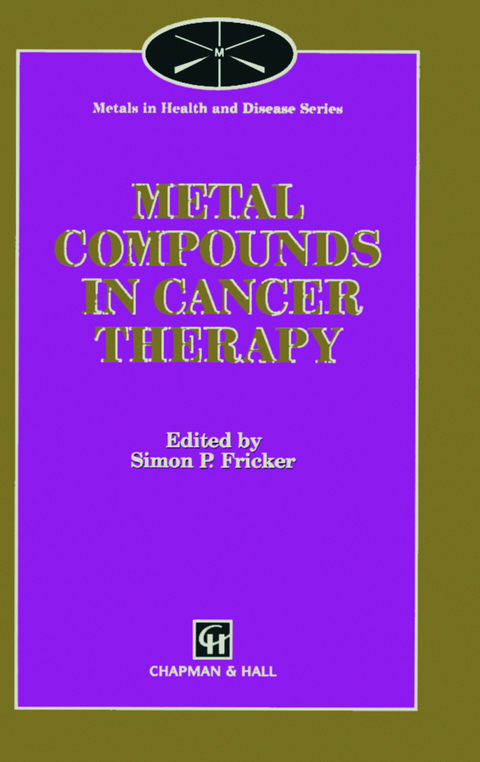
Metal Compounds in Cancer Therapy
Springer (Verlag)
978-94-010-4545-2 (ISBN)
1 Introduction.- 1.1 The Discovery of Cisplatin.- 1.2 Cancer-the Target.- 1.3 The role of Metals in Cancer Therapy.- 1.4 The Search for New Drugs.- 1.5 The Way Forward.- References.- 2 Platinum Anticancer Drugs.- 2.1 Introduction.- 2.2 Platinum Chemistry.- 2.3 Mechanism of Action.- 2.4 Platinum Pharmacology.- 2.5 Platinum Toxicology.- 2.6 The Clinical Impact of Platinum-Based Anticancer Drugs.- 2.7 The Search for New Platinum-Based Anticancer Drugs.- 2.8 Summary.- References.- 3 Gold.- 3.1 Introduction.- 3.2 Gold Chemistry.- 3.3 Gold Biochemistry and Pharmacology.- 3.4 Antitumour Activity of Auranofin and Analogues.- 3.5 [?-Bis(diphenylphosphine)ethane]Digold Species.- 3.6 Bis[1,2-bis(diphenylphosphino)ethane]Gold(I)and Related Complexes, [Au(P-P)2]+.- 3.7 Gold Complexes of Known Antitumour Agents.- 3.8 Other Active Compounds.- 3.9 Cisplatin Analogues.- 3.10 Conclusions.- Acknowledgement.- References.- 4 Ruthenium Compounds in Cancer Therapy.- 4.1 Introduction.- 4.2 Chemical Properties Relevant to Tumour Treatment.- 4.3 Effects on Cancer Growth.- 4.4 Conclusions.- Acknowledgement.- References.- 5 Rhodium, Iridium and Palladium Compounds as Experimental Anticancer Drugs.- 5.1 Introduction.- 5.2 Rhodium.- 5.3 Iridium.- 5.4 Palladium.- 5.5 Comments.- References.- 6 Organometallic Titanium, Vanadium, Niobium, Molybdenum and Rhenium Complexes - Early Transition Metal Antitumour Drugs.- 6.1 Introduction.- 6.2 Antitumour Activity of Titanocene and Vanadocene Dichlorides, Two Neutral Organometallic Complexes of Early Transition Metals.- 6.3 Antitumour Activity of Ionic Titanocene Complexes, Another Type of Organometallic Early Transition Metal Compound.- 6.4 Toxicological and Pharmacokinetic Properties of Neutral Titanocene and Vanadocene Dichloride Complexes.- 6.5 Phase IClinical Trial with Titanocene Dichloride.- 6.6 Antitumour Activity of Ionic Niobocene, Molybdenocene and Rhenocene Complexes, Newly Developed Organometallic Early Transition Metal Complexes.- 6.7 Antitumour Activity of Inorganic Bis(?-diketonato)-Titanium Complexes in Preclinical and Phase I Clinical Trials.- 6.8 Summary and Outlook.- Acknowledgements.- References.- 7 Antitumour Activity of Tin Compounds.- 7.1 Introduction.- 7.2 Early Antitumour Studies Involving Metal Derivatives.- 7.3 Tin Analogues of Cisplatin.- 7.4 Other in Vivo Studies Involving Tin Compounds.- 7.5 In Vitro Studies using Tin Derivatives.- 7.6 Mode of Action.- 7.7 The use of Tin Derivatives in the Photodynamic Therapy of Cancer.- 7.8 Concluding remarks.- Acknowledgements.- References.- 8 Gallium Compounds in Cancer Therapy.- 8.1 Introduction.- 8.2 In Vitro Studies.- 8.3 In Vivo Studies.- 8.4 Clinical Studies.- References.- 9 Bleomycin and Metal Interactions.- 9.1 Introduction.- 9.2 The Activation of Oxygen to Reactive Intermediates by Transition Metal Ions.- 9.3 Binding of Metal Ions to Bleomycin.- 9.4 Binding of Bleomycin to DNA.- 9.5 The Antitumour Activity of Bleomycin.- 9.6 Bleomycin used as a Biological Tool to Detect and Measure Low Molecular Mass Iron in Body Fluids.- Acknowledgements.- References.- 10 The in vivo use of Metallic Radioisotopes in Cancer Detection and imaging.- 10.1 Introduction.- 10.2 Tumour Imaging Applications of Simple Chelates.- 10.3 Tumour Imaging and Therapeutic Applications of Bifunctional Chelates.- 10.4 Radioisotopes.- 10.5 Novel Pretargeting Approaches.- 10.6 Conclusions.- References.
...provides a helpful entry and useful references to an advancing area mainly from the biochemical standpoint - Human & Experimental Toxicology; For those in the area it is an essential reading/reference work... It is an important series to launch at this time and is strongly recommended. - Platinum Metals Review
| Zusatzinfo | XIV, 256 p. |
|---|---|
| Verlagsort | Dordrecht |
| Sprache | englisch |
| Maße | 155 x 235 mm |
| Themenwelt | Medizin / Pharmazie ► Medizinische Fachgebiete ► Onkologie |
| Medizin / Pharmazie ► Medizinische Fachgebiete ► Pharmakologie / Pharmakotherapie | |
| Medizin / Pharmazie ► Pharmazie | |
| Naturwissenschaften ► Biologie ► Biochemie | |
| Naturwissenschaften ► Chemie ► Anorganische Chemie | |
| ISBN-10 | 94-010-4545-3 / 9401045453 |
| ISBN-13 | 978-94-010-4545-2 / 9789401045452 |
| Zustand | Neuware |
| Haben Sie eine Frage zum Produkt? |
aus dem Bereich


